Pages That Mention upper Sonoran
1925: Joseph Grinnell's field notes
S2 Page 8
Collector: Grinnell - 1925 Location: Lassen Section (Mineral) Date: June 14, 1925 Page Number: 2464
zone is supposedly Upper Sonoran! I have heard no owls here yet, and seen only one hawk, the Sharp shinned. A Sierra Grouse, in dense growth of lodgepole pines of large size, "hoots" at intervals thruout the day, at least from 10 to 3 (not early or late); rather, he "boonts" - a low muffled "thump, thump, thump, thump"; at a distance one hears only about four of these notes. Dixon located the grouse, an old (long-tailed) female, but it flew when he was yet 70 yards off. I have spent a lot of time watching Ruby-crowned Kinglets, which are common enuf to be within hearing of almost wherever a person may be. This afternoon late, I heard the monotonous "dinge", yerrup, yerrup, yerrup, etc., minutes together, which means concern. I finally located the two Kinglets giving it, far above in the tops of some lodgepole pines and firs; but the foliage was too dense for me to see the cause. This was where I had previously seen the Sharpshin, and also whence I had hear a chickadee "chicken"; either, or something else, may have made threatening advances. A Kinglet I watched a little later foraged about at the end of branches close to the summit of a fir fully 150 feet tall, every now and then singing without stopping it its fluttering, zigzag course. Presently the bird flew to an equally tall dead fir
S2 Page 68
Collector: Grinnell - 1925 Location: Mineral to Red Bluff and back Date: July 6 Page Number: 2521
A western House Wren, again, in snow-brush near camp, singing sketchily. Two Brewer Blackbirds flew over.
Today, went to Red Bluff and back - an impressive lesson in the variation of temperature inversely with altitude! The dryness below 3500 feet was also impressive; and the blueness of all the perennial vegetation (ceanothus cuneatus, Douglas Oak, and digger pine) in the Upper Sonoran. That zone might be called the "blue zone", Transition the "light green zone", Canadian the "dark green zone". These color-tone differences indicate, of course, fundamental conditions affecting physiological processes in ^the plants - temperature of growing season, length of growing season, dryness of air, soil-water supply, and perhaps others (such as insolation).
Four or five miles east of Red Bluff saw the usual Raven, whose headquarters I guess are somewhere around Tuscan Buttes. Western Kingbirds were most noticeable of birds in the immediate precincts of Red Bluff - noisy despite the intense heat of midday - indeed; indeed, the ^bickering notes of this species are inseparable, associated in my mind with the summer heat of the Great Valley. Of considerable interest was our frequent interrupting of Turkey Vultures along the highway, all the
S3 Page 31
Collector: Grinnell - 1925 Location: La Grulla, 7200 ft. Date: Oct. 7 Page Number: 2574
6434 Gray Fox (female sign) 10 lbs. (by "handcuff" scales). 915x365x121x70. Caught in a setting of one no. 0 newhouse trap under a cascara bush on the side of "Microtus" gorge. Bait, bird and mouse bodies. I have seen a number of fox foot-prints in trails before the rain; also a few of Coyote -- but curiously we have heard no note of the latter. I have been trying for Spilogale -- but not a smell! I doubt if Heller's specimen came from up here; more likely it came from an upper Sonoran locality; this should be looked into carefully, by checking dates against localities in his [Elliot's] report. Besides birds taken, I noted the following: Green backed Goldfinch(2, one of which was giving the food call of a juvenile; Sharp-shinned Hawk (seen twice); Anna Hummer (1); Rufous Hummer (1); Crossbill (unmistakable notes heard in the distance); Pinyon Jay (a noisy troupe around again today); California Jay (the first one I have seen appeared on the brushy hillside back of camp near noon, was "squeaked" [my jay call] into a nearer pine, but stayed out of range). 6435 Mountain Chickadee (male sign) ad. 12.2g. Shot from small pine. 6436 Cabanis Woodpecker (female sign) 57g. Shot at cluster of cones 75 feet up in pine, pecking out seeds. 6437 Merriam Chipmunk (male sign) 57.5g. 215x86x32.5x15. Two Jeffrey pine seeds in each of the cheek-pouches.


